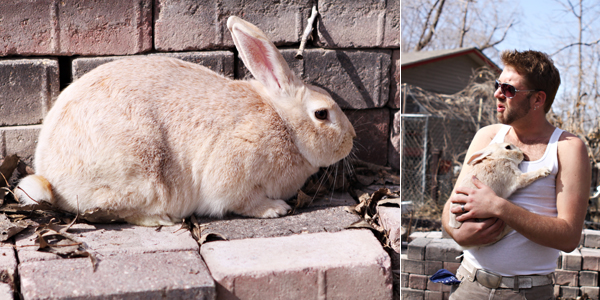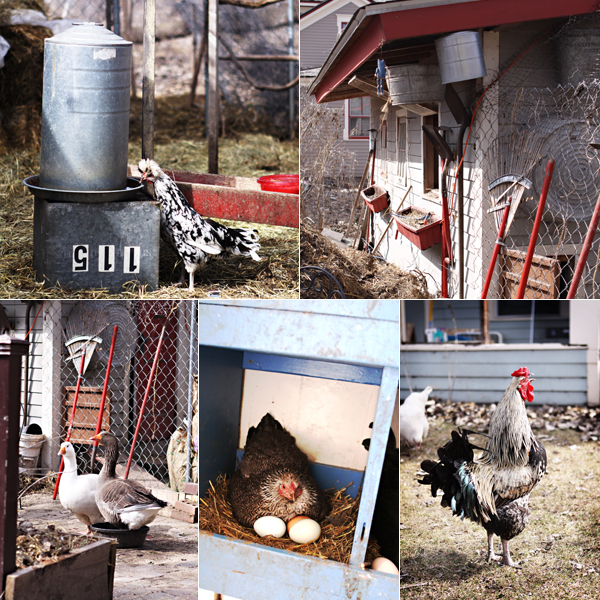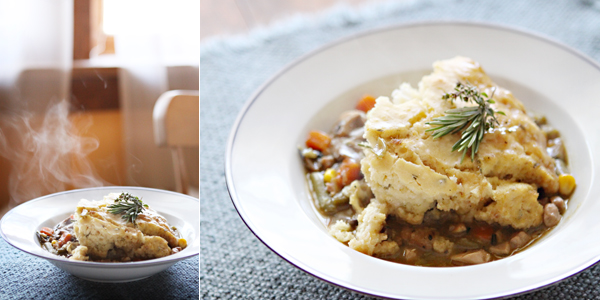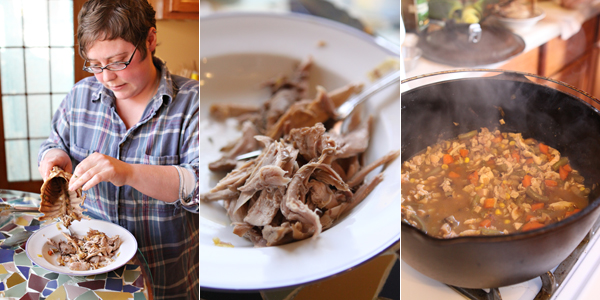
Karen Cross, Liz Hare, Peat Willcutt, and their neighbors are living a revolution, but it would be near impossible to notice unless you sneak into their shared backyard on Nicollet Island. They and other members of their low-income housing co-op worked to turn it and a nearby vacant lot into a fruit and vegetable garden and barnyard populated by a sundry congregation of ducks, geese, chickens, and rabbits. The residents are just as diverse, ranging from artists to cooks to musicians, and many of them hold at least an amateur-level interest in low-impact living. Soon, their operation won’t be the only one: Two more rabbitries will be starting up on the island this year.
While it’s fairly easy for a hip urbanite to understand the appeal of raising laying hens in the city (or the suburbs), the practice of raising and slaughtering meat rabbits, which is known as cuniculture, can be somewhat off-putting. Willcutt credits his interest in urban agriculture to his maternal grandmother, who spent her childhood living in wartime Germany. “You were given a 1,000-calorie-a-day ration card, so they had chickens, ducks, and geese, and the neighbor had a milk goat and kept rabbits and pigeons too. Without those alternative food sources, they would have had very little protein for a family of four. If it weren’t for those animals, I wouldn’t be here!” Hare, who incidentally has difficulty stomaching rabbit meat due to their uncanny link to her last name, grew up in a community of hunters. She remembers “coming home from school to find something dead on the doorstep… that was food.”
Raising your own meat is about taking ownership, says Willcutt. “Food is more intimate than sex, to take a phrase from [The Splendid Table host] Lynne Rossetto Kasper. If you’re going to put that into your body, it becomes a part of you.” For him, eating factory-farmed, anonymous meat would be akin to internalizing the horrific conditions at most commercial stockyards and slaughterhouses. By rearing rabbits and poultry, it is possible to become completely self-reliant for one’s protein needs. “What’s important,” says Willcutt, “is giving the animal a full, rich, natural life and a quick, humane death.”

Not many Americans can (or want to) reminisce about their food before it became food; Cross, Hare, and Willcutt cherish their ability to say, “This hen was a good hen up until we turned her into soup!” Cross laments the majority of Americans’ alienation from their food, for whom “milk comes from a carton and meat comes in styrofoam.” To counter that kind of depersonalization, Willcutt names all of the animals: For example, the rabbits all have vegetable-inspired names, such as Sugar Beet and Parsnip. An acquaintance of mine who raises meat rabbits in Britain gives her rabbits excruciatingly dorky British names like Mr. Plantagenet, Lord GaGa, and the names of pretty much every character in Frances Hodgson Burnett’s The Secret Garden.
The rabbits on the Nicollet Islanders’ property come in two breeds: Creme d’Argent and Champagne d’Argent. Champagne d’Argents are known as one of the oldest breeds of domesticated rabbit, and Cremes are derived from that breed. According to Willcutt and the American Livestock Breeds Conservancy, the first true rabbit breeders were Medieval French monks, who raised them to eat as meat “alternatives” during fasting periods such as Lent. The story goes that fetal and newborn rabbits, known as “laurices,” were declared to be fish by papal authorities in order to lessen to burden of fasting. This effectively circumvents the dietary restrictions laid out in Deuteronomy 14:7, which prohibit Catholics from eating rabbits due to their “unclean” nature. In a similar vein, the Vatican officially found capybaras to be fish as well in a concession to the Church’s South American followers. Makes sense. If Jesus can turn water into wine, why not lagomorphs and rodents into fish? These days, most rabbit enthusiasts prefer to eat slightly older rabbits.
Though the most typical meat rabbit breeds are the Californians and New Zealands, Willcutt chooses to raise Argente types because of their historical significance and contemporary rarity. According to the American Rabbit Breeders Association, there are only 1,000 Creme d’Argents left in the world. Flatland Farm, based in southern Minnesota, raises both breeds. The Argente types owe their rarity to the overwhelming popularity of white rabbits, whose flesh turns out pinker. Argente rabbits’ flesh, on the contrary, is darker and is viewed by retailers and consumers as less appetizing. Otherwise, their taste and size are very similar to other types of domesticated meat rabbit.
For the fledgling urban agrarian, it might be useful to note that rabbits are much easier to keep than chickens. They don’t require special feed: just grass clippings and hay. Compared to, say, cows and pigs, rabbits are much more efficient metabolizers. Their famous breeding habits are quite efficient as well. Once pregnant, a rabbit doe will give birth in about a month. Rabbits’ space requirements are also modest: Willcutt and company keep theirs in a small section of a shed, though most cuniculturalists prefer to keep them in individual stackable cages. Thanks to the breeds’ compatibility with colder climates, Willcutt only needs to bring the rabbits indoors during periods of severe (i.e., -20°F) weather. An excellent guide to raising rabbits may be found at Rudolph’s Rabbit Ranch. Novella Carpenter’s book, Farm City: The Education of an Urban Farmer, also goes into great detail regarding her adventures in rabbit husbandry.

Depending on the age of a given rabbit, it can be classified as either a “fryer” or “roaster.” Fryers are young rabbits, about 3 months in age, and can be substituted for chicken in any preparation. Roasters are more mature and should really only be stewed or braised. They can weigh up to 9 or 10 pounds, with enough meat to feed several people. Depending on the rabbit, the taste can be bland and chickenesque or pungent. Wild rabbits tend to taste gamier overall, as many hunters and friends-of-hunters can testify.
Fortunately for Minneapolitan rabbit farmers, city ordinances allow residents to keep a maximum of three rabbits that are over four months old at any given time. (St. Paul is noticeably more relaxed when it comes to non-traditional pets.) As most meat rabbits are supposed to be slaughtered at three months anyway, Minneapolis law works very well with a backyard rabbitry’s schedule.
Killing a rabbit is a piece of cake, as absolutely terrible as that sounds. You could go for a swift blow to the back of the neck with your hands or a broomstick, which also correlated to an illegal move known as the “rabbit punch” in boxing circles. Willcutt either smashes the rabbit’s brains in with a brick or quickly decapitates it. One tool that is gaining in popularity is the Rabbit Wringer, a device which enables one to slaughter a rabbit with a simple pulling motion. Unless you opt to send your animals away to a slaughterhouse, there’s really no way to get around the ugly fact that you’re killing an animal for its flesh.
Rabbit meat is growing in popularity in urban centers — New York City’s Babbo Ristorante and the Napa Valley’s French Laundry frequently feature rabbit dishes. Several restaurants in the Upper Midwest have also embraced it, including The Creamery in Menomonie, WI and Twin Cities restaurants Bar La Grassa (Orecchiette with Braised Rabbit, $8 / $16), The Craftsman (rabbit confit, $24), Restaurant Alma (Rabbit & Polenta, $13), and St. Paul’s Little Szechuan (Big Sister Diced Rabbit, $8.95). In fact, Chef Mike Phillips of The Craftsman is actively trying to track down rabbit breeders in the Twin Cities in order to bulk up his supply.
If you’re looking to start your own rabbit operation, all you need to start with are three rabbits: one male and two females. You can acquire them easily for around $20 to $50 from a rabbit breeder, if you can find one. A great resource for Upper Midwest breeders is the American Rabbit Breeders Association directory. Whether you decide to feed your rabbits pellets, grass clippings, or kitchen scraps, it will rarely add up to more than $4 per rabbit from birth to slaughter. If you want to get deep into the numbers, this North Dakota State University guide to rabbitry has an excellent economic breakdown of rabbit management. The most expensive portion of a rabbitry would probably be the infrastructure, though someone with a DIY attitude could probably circumvent that as well.

To prepare the rabbit Willcutt graciously gifted to us, we adapted a New York Times recipe for chicken and vegetable cobbler, adjusting the braising time and swapping in some fresh herbs from a frosty Minnesota garden. Eating something that once had a name can be jarring at first, but, as Compassionate Carnivore author Catherine Friend notes, at least then you know whom to thank.
Rabbit Cobbler
Serves 4-6 as a main dish
Adapted from the original recipe from the New York Times
3 tbsp olive oil
1 leek, well washed and chopped
Salt and black pepper
2 c quartered button mushrooms
1 ½ c or more chicken stock or, if you have the foresight, rabbit stock
1 sprig fresh, chopped rosemary, plus more to mix into the cobbler batter
2 medium carrots, cut into coins
1 butchered rabbit
1 c peas, frozen or fresh
2 tbsp assorted fresh herbs (e.g., chives, lemon thyme, etc.)
1 c corn, frozen or fresh
2 tbsp cornstarch
2 c flour
1 ½ tsp baking powder
¼ tsp baking soda
½ tsp salt
4 tbsp unsalted butter, cut into bits
1 cup buttermilk
2 eggs
- Heat oven to 375°F. Put oil in a large skillet over medium heat. When oil is hot, add the leek, sprinkle with salt and pepper, and cook, stirring occasionally, until softened, about 5 minutes. Add mushrooms and cook until liquid has released and evaporated, about 5 minutes.
- Add stock and rosemary; bring to a boil, and let bubble for a minute or two, then add carrots and rabbit and reduce heat so the liquid simmers. Cook until carrots are almost tender and rabbit is cooked through — 30 to 40 minutes, depending on the type of rabbit. Pull out the rabbit parts and pull the meat from the bone. Chop up the meat and add it back into the pot. Add peas, herbs, and corn and cook, stirring occasionally, until vegetables are brightly colored and just tender, another minute or so.
- Whisk cornstarch with a few tablespoons of broth to make a slurry. Add slurry to pot and stir until liquid thickens slightly. Transfer everything to an ovenproof dish and set aside.
- Put flour in a food processor with rosemary, baking powder, baking soda, and salt. Add butter and process until mixture resembles small peas, no more than 30 seconds. (You can also do this by hand, using two knives, a fork, your fingers, or a pastry cutter). Transfer mixture to a bowl and mix in buttermilk and eggs until it just comes together; it should be sticky.
- Drop spoonfuls of batter on top of vegetables and rabbit and smooth with a knife, covering as much surface area as possible but leaving a few gaps for steam to escape. Bake for 35 to 45 minutes until golden on top and bubbly underneath. Scoop into bowls and serve immediately.
Special thanks to Katie Hochstedler for her assistance with this recipe.


Is it just a coincidence that her name is Liz Hare? No pun intended….
Barbary Fig in St. Paul regularly serves rabbit dishes, has for 20 years. Good stuff!
I like the tone of this article, but there’s one major point I must bring up: You cannot feed rabbits on ‘grass clippings and hay’ and wind up with a balanced and complete diet, which is necessary if one is to have a healthy, productive herd.
That would be like you and I eating nothing but chocolate and lettuce. Tasty, and looks pretty good, but not good *for* us.
A complete and balanced pellet, with or without intelligently-chosen supplementation, is today’s best option for healthy and happy rabbits.
For the best information available on raising rabbits for meat, I recommend the book Rabbit Production, by Cheeke, Patton, Lukefahr & McNitt; the yahoogroup Meatrabbits (http://groups.yahoo.com/group/Meatrabbits/); and membership in the American Rabbit Breeders Association.
There is also a humane slaughter video available from the Rabbit Industry Council which addresses humane and sanitary rabbit slaughter (http://www.battats.com/video ).
Excellent and informative article!
Heheh, I’ll bet those rabbits are dipping into the chicken feed… :-) Although alfalfa and grass is probably close to adequate, if you added whole oats (available at a feed store), I think you’d get more meat on those fryers without a huge additional investment.
And, I do recommend http://www.raising-rabbits.com as an easy-to-use, comprehensive rabbit-raising resource.
Thanks for the input and additional resources, guys! Peat was using alfalfa pellets to feed his rabbits as well, and I erred in not mentioning that.
These people are SICK! Naming the animals, giving them a “full, rich life” and then MURDERING them?! What kind of commie pinko people ARE you? A bunch of savages! There is NO need to eat rabbit in this day and age. DISGUSTING. I can’t even believe this is LEGAL. And you’re BRAGGING about it. UGH. Who knows what other kind of perverted things you’re into…
Teresa, would you rather they be abused, neglected, then beaten to a pulp or torn limb from limb? How about the whole ‘nature’ thing, where they live short, nasty, brutal lives before dying at the jaws and paws of carnivorous predators?
I love every single one of my rabbits, and they are all raised for food production. They are protected, healthy, well-cared-for and yes, respected and held to be of value for more than just their meat and fur.
You say there is no need to eat rabbit in this day and age; I and many others disagree. Rabbit meat is one of the most lean, highest and best quality protein meats available to us today, lowest in cholesterol, and it’s also the most humanely raised of all the commercial food animal species. No hormones, no antibiotics, just good husbandry.
Rabbit meat is also frequently recommended as a substitute for chicken and other meats when people are in the throes of heart trouble; its low cholesterol and smaller portion size (due to the density of the meat) is ideal.
Sorry to hear you disagree; hope you enjoy your non-rabbit-meat-containing diet now and in the future.
When my rabbit numbers increased, I dispensed with naming my future meals, but before then, they were given food names, like Pepper, Spicy, Taco, etc. After I grew up, I learned to raise and appreciate home-raised meat. I petted and played with and thoroughly enjoyed the antics of animals destined for the pot. They enriched our family life, sometimes our budget, and we appreciated them even after death. At the same time, we invested much time and effort into caring for and safeguarding their health and welfare. It was a good trade.
Teresa, your comments are only valid if you eat no meat nor use any animal products. Otherwise, you fall into the category of hypocrite. Cattle are cute and friendly too. I have a pet hen who follows me around the barn. Pigs, well, pigs are more affectionate than the average dog and easier to train!
Rabbits are wonderful animals and their meat is not only highly nutritious, but also one of the most easily digestible proteins available. For people with certain gastric cancers, Krohn’s disease or undergoing chemotherapy, rabbit meat may be the only protein they can digest.
Teresa, when the stores are empty, I will sell you one rabbit for you to KILL, and then EAT but the price will be very high!
Very nice site!
@TERESA BEASLEY I really feel sorry for you if you’re ever in a situation where you have to survive on your own. Bet you can’t imagine a day without a cell phone or internet or T.V. etc. Without meat protein, eventually you become Vitamin B-12 deficient. If you’re in a strange place without stores, money or provisions…you’re not going to plant something and wait for it to grow, and it’s doubtful you have the knowledge or availability to find enough veggies on the wild to survive. No, you’ll either fish or try to kill something to eat. It’s nature that places rabbits here, and chickens, and cows, etc for us to eat. Today’s kids have no idea what life is really about. You can’t believe all that people tell you on the internet. Everyone wants to be part of a movement, or club, or group or cause…then one day reality slaps you in the face and you find your world is too small. I hope one day you find peace with the world around you.
As resident of Bloomington, MN, I would appreciate information about how to purchase locally raised and dressed rabbit meat.
My intentions are to use rabbit meat for my personal Jerky.
Ground rabbit meat preferred. Any chance of purchasing GROUND rabbit meat locally? (If not, I can grind it.)
Thank you for your kind information.